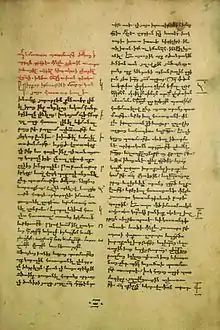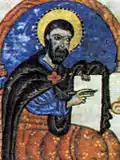Kirakos Gandzaketsi
Kirakos Gandzaketsi (Armenian: Կիրակոս Գանձակեցի; c. 1200/1202–1271) was an Armenian historian of the 13th century[2][3][4][5] and author of the History of Armenia, a summary of events from the 4th to the 12th century and a detailed description of the events of his own days.[1] The work concentrates primarily on the history of Medieval Armenia and events occurring in the Caucasus and Near East. The work serves as a primary source for the study of the Mongol invasions and even contains the first recorded word list of the Mongolian language.[6] The work has been translated into several languages including Latin, French and Russian.[7]

Life
Kirakos was born in the region of Gandzak (around Ganja, presently in Azerbaijan) in or around 1200.[4] He attended the school of New Getik (later known as Goshavank) in the village of Tandzut in the region of Kayen (classes were originally taught in a cave and it was only later that they relocated to a one-room building).[8] He was the pupil of Vanakan Vardapet, a scholar and native from his native Gandzak. In 1215, Kirakos along with his classmates and their teacher Vanakan moved to study at the monastery at Khoranashat in Tavush. With the Mongol invasion of the 1230s, Kirakos and his mentor were captured by Mongol forces in the spring of 1236.[1] As captives, however, he and Vanakan managed to serve as secretaries for the Mongols. During this time, Kirakos learned the Mongolian language and he later compiled his knowledge of it into a list of 55 words with their corresponding Armenian meanings.[9] A ransom was paid to free Vanakan in the summer of that year but Kirakos also managed to escape the same night and returned to the town of Getik.[10]
Following Vanakan's death in 1251, Kirakos assumed his former teacher's duties and became the head of the school in New Getik. In 1255, he was granted an audience with the leader of the Armenian Kingdom of Cilicia, Hetum I, in the town of Vardenis (in Aragatsotn), informing him of missionary work in the region.[1]
He remained in New Getik for several more years; he died in 1271 and was buried there.
Works
Kirakos completed several works in his lifetime; however, his most prominent work is History of Armenia (Patmutʻiwn Hayotsʻ, a generic title for Armenian histories). He began to write the book on May 19, 1241 and completed it in 1265.[1] Divided into two parts, the first part of his history begins with the life of Gregory the Illuminator, the patron saint of the Armenian Apostolic Church, and is devoted largely to the history of the Armenian church from the third century to the twelfth century. The second part focuses on the ramifications and physical damage inflicted against the people of the region by the Turkic and Mongol invasions, including the torture and death of Hasan-Jalal, the prince of Khachen.
Approximately 47 facsimiles of the 65 chapters of History of Armenia survived and can be found in numerous repositories located around the world including the Matenadaran in Yerevan, Armenia and museums in Vienna, London, Paris, and St. Petersburg.[1]
References
- Khanlaryan, L. «Կիրակոս Գանձակեցի». Soviet Armenian Encyclopedia. vol. v. Yerevan, Armenian SSR: Armenian Academy of Sciences, 1979, p. 450.
- Steven Runciman. A History of the Crusades. — Cambridge University Press, 1987. — Vol. I. — P. 335. "Later Armenian chroniclers, such as Samuel of Ani and Mekhitar of Airavanq, writing at the end of the twelfth century, and Kirakos Gandzaketsi and Vartan the Great, in the thirteenth century, treat only briefly of the First Crusade."
- René Grousset. The Empire of the Steppes: A History of Central Asia. — Rutgers University Press, 1970. — P. 282. "Mongka gave a warm welcome to this faithful vassal and handed him a yarligh of diploma of investiture and protection, "a diploma", says the Armenian chronicle of Kirakos, "bearing his seal and explicitly forbidding any action against the person or states of Hethum. He also gave him a charter enfranchizing churches everywhere." Another Armenian historian, the monk "Hayton", in his Flor des extoires d'Orient, states in addition that Mongka gave his visitor an assurance that a great Mongol army under his brother, Hulagu khan, would attack Baghdad; destroy the caliphate, their "mortal enemy"; and restore the Holy Land to the Christians."
- S. Peter Cowe. Kirakos Ganjakec'i or Arewelc'i // Christian-Muslim Relations. A Bibliographical History / Edited by David Thomas & Alex Mallet. — BRILL, 2012. —vol. IV. — p. 438: "Kirakos is one of the most important Armenian historians of the 13th century. He was born in the region of Ganja and received his early formation at the monastic school of Nor Getik under the eminent savant Vanakan Vardapet."
- Abaqa — Encyclopædia Iranica. Peter Jackson
- Zgusta, Ladislav, Franz J. Hausmann and Oskar Reichmann (eds.). An International Encyclopedia of Lexicography. Berlin: Walter de Gruyter, 1991, p. 2368. ISBN 3-11-012421-1.
- Hacikyan, Agop Jack; Basmajian, Gabriel; Franchuk, Edward S. (2005). The Heritage of Armenian Literature: From the Eighteenth Century to Modern Times, vol. 3. Detroit: Wayne State University. p. 494. ISBN 0-8143-3221-8.
- Hacikyan et al. Armenian Literature, p. 493.
- Lane, George E. (2003). Early Mongol Rule in Thirteenth-Century Iran: A Persian Renaissance. London: Routledge. p. 12. ISBN 0-415-29750-8.
- Bedrosian, Robert. Kirakos Ganjakets'i's History of the Armenians: Translator's Preface. Robert Bedrosian’s Homepage. New York, 1986. Accessed March 7, 2008.
Further reading
- Bayarsaikhan, Dashdondog (2019). "Kirakos Gandzakets'i, as a Mongol Prisoner". Ming Qing Yanjiu. 22 (2): 155–163. doi:10.1163/24684791-12340027.
External links
- An English translation of Kirakos Gandzaketsi's History of the Armenians by Robert Bedrosian.
- English translation of the History of the Armenians - mirror if main site is unavailable
